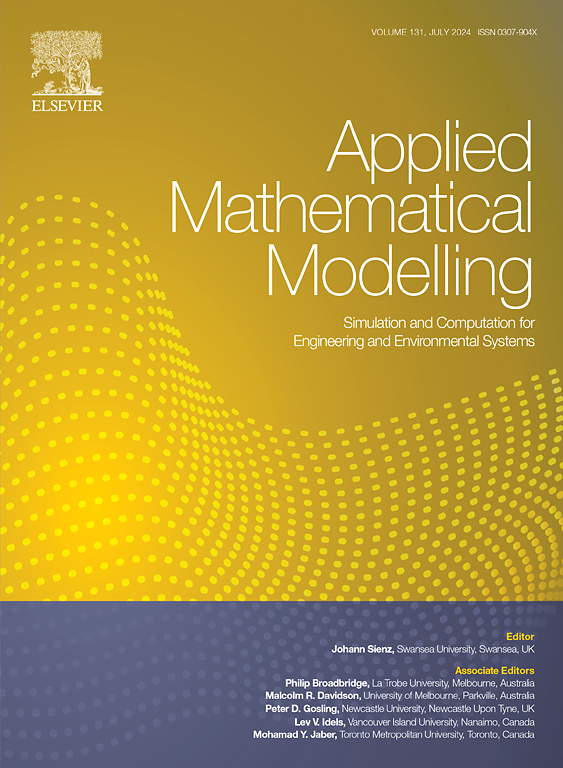基于互耦动力减振器的摩擦节理梁建模与非线性分析
IF 4.4
2区 工程技术
Q1 ENGINEERING, MULTIDISCIPLINARY
引用次数: 0
摘要
本文研究了基于干涉的动态吸振器(IDVA)在非线性节理梁结构中抑制振动的有效性。首先推导出控制偏微分方程,用有限元法对其进行离散,然后用伽辽金法将其转化为常微分方程。为了有效地计算稳态动态响应和振动潮流变量,采用了频率-时间(HB-AFT)格式的谐波平衡法。结果表明,与其他设计相比,提出的接地IDVA设计具有更好的减振和吸能效果。非线性摩擦节理表现出不同的行为,取决于极限摩擦力:在较小的极限摩擦力下,节理表现为摩擦阻尼器,导致较低的响应峰值和潜在的粘滑运动;在较大的极限摩擦力下,该节点起到加强作用,诱导全粘滞行为并增加固有频率。此外,刚度非线性主要影响第3和第5共振峰附近的系统响应,而惯性值显著影响第1共振峰。功率耗散特性随激励频率的变化而变化,其中IDVA耗散了第一和第二谐振频率之间的大部分能量。一种设计建议是将IDVA放置在远离固定边界的位置,以最小化系统的动态响应和动能。本文章由计算机程序翻译,如有差异,请以英文原文为准。
Modelling and nonlinear analysis of frictional jointed beams with inerter-based dynamic vibration absorber
This study investigates the effectiveness of an inerter-based dynamic vibration absorber (IDVA) in suppressing vibrations in a nonlinearly jointed beam structure. The governing partial differential equations are derived and discretized using the finite element method, followed by transformation into ordinary differential equations via the Galerkin method. To efficiently compute the steady-state dynamic response and vibration power flow variables, the harmonic balance method with an alternating frequency–time (HB-AFT) scheme is employed. The results demonstrate that the proposed grounded IDVA design achieves superior vibration reduction and energy absorption compared to other designs. The nonlinear frictional joint exhibits distinct behaviour depending on the limit friction force: at smaller limit friction forces, the joint behaves as a frictional damper, resulting in lower response peaks and potential stick-slip motion at the beam tips; at larger limit friction forces, the joint acts as a stiffener, inducing full-stick behaviour and increasing the natural frequency. Additionally, the stiffness nonlinearity primarily influences the system response near the third and fifth resonant peaks, whereas the inertance value significantly affects the first resonant peak. The power dissipation characteristics vary with excitation frequency, with the IDVA dissipating the majority of energy between the first and second resonant frequencies. A design suggestion is to position the IDVA away from the fixed boundary to minimize both the dynamic response and the kinetic energy of the system.
求助全文
通过发布文献求助,成功后即可免费获取论文全文。
去求助
来源期刊

Applied Mathematical Modelling
数学-工程:综合
CiteScore
9.80
自引率
8.00%
发文量
508
审稿时长
43 days
期刊介绍:
Applied Mathematical Modelling focuses on research related to the mathematical modelling of engineering and environmental processes, manufacturing, and industrial systems. A significant emerging area of research activity involves multiphysics processes, and contributions in this area are particularly encouraged.
This influential publication covers a wide spectrum of subjects including heat transfer, fluid mechanics, CFD, and transport phenomena; solid mechanics and mechanics of metals; electromagnets and MHD; reliability modelling and system optimization; finite volume, finite element, and boundary element procedures; modelling of inventory, industrial, manufacturing and logistics systems for viable decision making; civil engineering systems and structures; mineral and energy resources; relevant software engineering issues associated with CAD and CAE; and materials and metallurgical engineering.
Applied Mathematical Modelling is primarily interested in papers developing increased insights into real-world problems through novel mathematical modelling, novel applications or a combination of these. Papers employing existing numerical techniques must demonstrate sufficient novelty in the solution of practical problems. Papers on fuzzy logic in decision-making or purely financial mathematics are normally not considered. Research on fractional differential equations, bifurcation, and numerical methods needs to include practical examples. Population dynamics must solve realistic scenarios. Papers in the area of logistics and business modelling should demonstrate meaningful managerial insight. Submissions with no real-world application will not be considered.
 求助内容:
求助内容: 应助结果提醒方式:
应助结果提醒方式:


